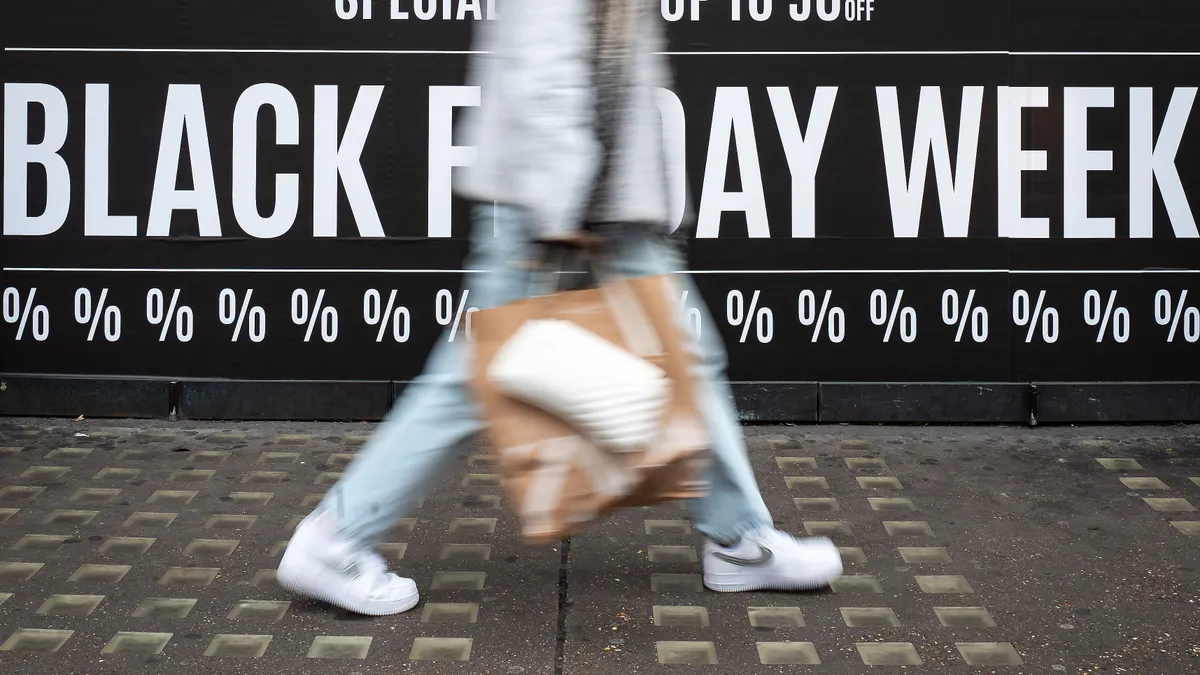Dive Brief:
- Consumer spending fell last month for the first time since March, adding to signs the economy is cooling as the Federal Reserve curbs inflation by holding borrowing costs at the highest level in 22 years.
- Retail sales declined 0.1% in October after a 0.9% gain the prior month, the Commerce Department said Wednesday. Consumers cut spending at gas stations, and in stores and car dealerships.
- “Consumers are feeling the weight of multiple economic pressures and discretionary retail has borne the brunt of this weight,” Christina Hennington, chief growth officer at Target, said Wednesday after the company reported a 4.9% decline in comparable sales during the three months ended Oct. 28 compared with the same period last year. Consumers face “newly emerging headwinds, including higher interest rates and the return of student loan payments.”
Dive Insight:
Shrinking retail sales, along with recent reports of reduced hiring and falling price pressures, suggest that the Fed may achieve a so-called soft landing for the economy despite its most aggressive monetary tightening in four decades.
Gross domestic product defied forecasts of recession earlier this year and surged at a 4.9% annual pace during the third quarter.
“Clearly the U.S. economy has been stronger than expected — it's been more resilient — and this year is just remarkable,” Fed Chair Jerome Powell said Thursday.
Policymakers have never raised borrowing costs to quash high inflation without also pushing the economy into recession. Since March 2022 they have increased the federal funds rate from near zero to a range between 5.25% and 5.5%.
The Fed has held the main rate steady in its past two meetings amid signs prices are stabilizing.
The producer price index for final demand, a measure of what suppliers charge, fell 0.5% last month in the biggest decline since April 2020, the Labor Department said Wednesday. Producer prices rose 0.4% in September.
Companies often pass on to consumers the higher cost of inputs.
Meanwhile, the consumer price index excluding volatile food and energy prices rose at a 4% annual rate in October, slower than forecast, lower than in September and August, and the slowest annual pace since September 2021, the Labor Department said Tuesday.
In an indication of further belt-tightening, consumers during the coming weeks plan to spend $985 on holiday-related items, or 2% less than last year, the Conference Board found in a survey.
Consumer sentiment slipped in November for the fourth straight month, declining 5% compared with October, the University of Michigan said Friday in a description of survey results.
“It feels like in the surveys, people express a pessimism that has a lot of retail-and-consumer-goods people nervous about this holiday season,” Chicago Fed President Austan Goolsbee said Tuesday at the Detroit Economic Club.
Along with higher borrowing costs and the resumption of student loan payments, consumers face the prospect of a rebound in energy prices as Washington and Tel Aviv warn that the Israel-Hamas conflict may expand into a regional war.
Consumers are also trimming post-lockdown “revenge spending” as they run down much of their savings from federal aid provided during the pandemic.
Like Target, Home Depot reported a decline in sales in recent months.
“We saw continued customer engagement with smaller projects and experienced pressure in certain big-ticket discretionary categories,” Home Depot CEO Edward Decker said Tuesday on a quarterly earnings call.
The company’s same store sales shrank 3.1% during last quarter in what Decker called a “period of moderation for home improvement” spending.












